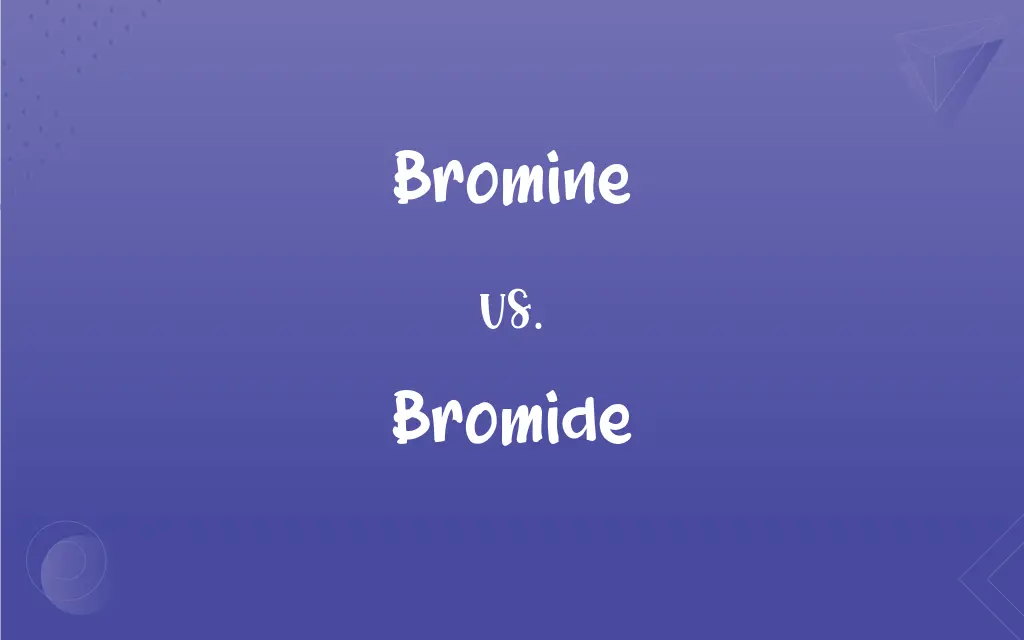Bromine vs. Bromide: What's the Difference?
By Janet White || Updated on December 8, 2023
Bromine is a dark, reddish-brown liquid element, while bromide is a compound containing bromine in its negative ion form.

Key Differences
Bromine, a chemical element with the symbol Br, is a dark, reddish-brown liquid at room temperature. Bromide, on the other hand, refers to a compound in which bromine exists as a negatively charged ion (Br-), typically combined with a metal or a cation like sodium or potassium.
In its elemental form, bromine is highly reactive and toxic, requiring careful handling. Bromide compounds, due to the ionic bonding of bromine, are generally more stable and less reactive than elemental bromine.
The uses of bromine are diverse, including in flame retardants, photography, and as a fumigant. Bromide compounds are often used in medical applications, such as sedatives and anticonvulsants.
The extraction of bromine typically involves the treatment of brine with chlorine. Bromides are often produced by reacting bromine with another element or compound, such as sodium hydroxide.
Environmentally, bromine can be a concern due to its role in ozone depletion when released into the atmosphere. Bromide ions in the environment are less of a concern, as they are more stable and less volatile.
ADVERTISEMENT
Comparison Chart
State at Room Temp.
Dark, reddish-brown liquid
Solid or part of a compound
Chemical Form
Elemental form (Br2)
Ionic form (Br-)
Reactivity
Highly reactive and toxic
Generally stable and less reactive
Common Uses
Flame retardants, photography
Medical applications (sedatives, anticonvulsants)
Environmental Impact
Ozone depletion concern when released into the air
More stable, less volatile in the environment
ADVERTISEMENT
Bromine and Bromide Definitions
Bromine
Bromine is a volatile, reddish-brown liquid at room temperature.
The distinct color of bromine makes it easily identifiable in a laboratory setting.
Bromide
Bromide salts are often used for their sedative effects in medicine.
Sodium bromide was historically used as a tranquilizer.
Bromine
Bromine is used in the manufacture of organic compounds in industry.
Bromine is crucial in the synthesis of certain dyes and pharmaceuticals.
Bromide
Bromides are stable ionic compounds in contrast to elemental bromine.
Magnesium bromide is used as a mild catalyst in organic reactions.
Bromine
Bromine is known for its strong and unpleasant odor.
The laboratory was ventilated after a spill of bromine due to its pungent smell.
Bromide
Bromide is a compound containing bromine in a negative ion form.
Potassium bromide is used in photography for its light-sensitive properties.
Bromine
Bromine is a halogen element with the atomic number 35.
Bromine is used in flame retardants because of its effectiveness in inhibiting combustion.
Bromide
Bromide ions are essential in some industrial chemical reactions.
Silver bromide is integral to traditional photographic film.
Bromine
Bromine plays a role in water treatment processes.
Bromine is added in small quantities to swimming pools to keep the water clean.
Bromide
Bromides are commonly found in seawater and mineral deposits.
Seawater contains a significant amount of bromide ions, which can be extracted.
Bromine
A dense, volatile, corrosive, reddish-brown, nonmetallic liquid halogen element that exists as a diatomic molecule, Br2 having a highly irritating vapor. Chiefly isolated from brines, it is used in producing fumigants, dyes, water purification compounds, and photographic chemicals. Atomic weight 79.904; atomic number 35; melting point -7.2°C; boiling point 58.8°C; density of gas 7.59 grams per liter; specific gravity (liquid, at 20°C) 3.12; valence 1, 3, 5, 7. See Periodic Table.
Bromide
Univalent anionic bromine, or a compound of bromine, especially a binary compound of bromine with a more electropositive element.
Bromine
(uncountable) A nonmetallic chemical element (symbol Br) with an atomic number of 35; one of the halogens, it is a fuming red-brown liquid at room temperature.
Bromide
Potassium bromide.
Bromine
(countable) A bromine atom
Bromine
One of the halogen elements, related in its chemical qualities to chlorine and iodine. Atomic weight 79.8. Symbol Br. It is a deep reddish brown liquid of a very disagreeable odor, emitting a brownish vapor at the ordinary temperature. In combination it is found in minute quantities in sea water, and in many saline springs. It occurs also in the mineral bromyrite.
Bromine
A nonmetallic largely pentavalent heavy volatile corrosive dark brown liquid element belonging to the halogens; found in sea water
FAQs
What are common bromide compounds?
Common bromide compounds include sodium bromide, potassium bromide, and magnesium bromide.
What is bromine?
Bromine is a chemical element, a dark reddish-brown liquid, and a member of the halogen group.
How is bromine used industrially?
Bromine is used in flame retardants, photography, and in the production of some pesticides.
What is a bromide?
A bromide is a chemical compound containing a bromide ion, where bromine is negatively charged.
Is bromine naturally occurring?
Yes, bromine is found in nature, mainly in seawater and mineral deposits.
Can bromine exist as a gas?
Yes, bromine can vaporize to form a reddish-brown gas with a pungent odor.
Is bromine used in water treatment?
Yes, bromine is used in some water treatment processes for disinfection.
Are bromides safe for medical use?
Bromides are used in some medications, but their use is limited due to potential side effects.
What are the environmental impacts of bromine?
Bromine compounds can contribute to ozone depletion if released into the atmosphere.
How are bromides used in photography?
Bromides, like silver bromide, are used in photographic films for their light-sensitive properties.
How are bromides formed?
Bromides are formed when bromine reacts with another element, like sodium or potassium.
What are the environmental impacts of bromides?
Bromides are less volatile and generally have a lower environmental impact than bromine.
Can bromides be used in fire extinguishers?
Some bromide compounds are used in fire suppression systems, particularly in specialized applications.
Is bromine reactive?
Yes, bromine is highly reactive and can form compounds with many elements.
Are bromides reactive?
Bromides are generally less reactive than elemental bromine.
Are bromides corrosive?
Bromides are not as corrosive as elemental bromine and are generally safer to handle.
Are bromides found in the human body?
Bromides are present in trace amounts in the human body but are not essential elements.
How is bromine extracted?
Bromine is typically extracted from seawater or brine pools through a chemical process involving chlorine.
What safety precautions are needed for bromine?
Bromine requires careful handling due to its toxicity and corrosive nature.
Can bromine be found in food?
Bromine is not typically present in food, but bromine-containing compounds may be used in some food additives.
About Author
Written by
Janet WhiteJanet White has been an esteemed writer and blogger for Difference Wiki. Holding a Master's degree in Science and Medical Journalism from the prestigious Boston University, she has consistently demonstrated her expertise and passion for her field. When she's not immersed in her work, Janet relishes her time exercising, delving into a good book, and cherishing moments with friends and family.































































